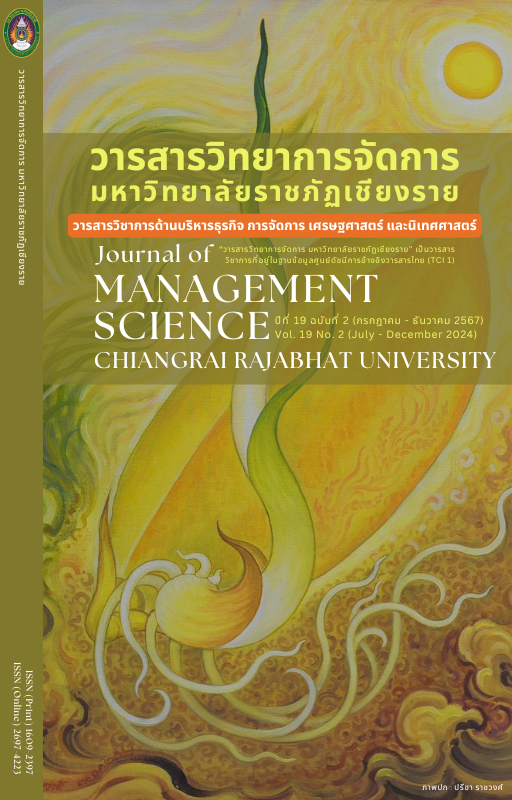ความตั้งใจเชิงพฤติกรรมต่อการท่องเที่ยวเชิงความเชื่อ ความศรัทธา จังหวัดมหาสารคาม
Main Article Content
บทคัดย่อ
งานวิจัยนี้มีวัตถุประสงค์ 1) เพื่อศึกษาพฤติกรรมของนักท่องเที่ยว 2) เพื่อศึกษาสิ่งดึงดูดใจทางการท่องเที่ยวของการเที่ยว และ 3) เพื่อศึกษาความตั้งใจเชิงพฤติกรรมของนักท่องเที่ยวเชิงความเชื่อ ความศรัทธา จังหวัดมหาสารคามโดยใช้ระยะเวลาวิจัยตั้งแต่เดือน ตุลาคม พ.ศ. 2564 ถึง เดือน กันยายน พ.ศ. 2565 ใช้แบบสอบถาม กับกลุ่มตัวอย่าง 400 คน
ที่เกี่ยวเนื่องกับการท่องเที่ยวเชิงความเชื่อ ความศรัทธา จังหวัดมหาสารคาม ใช้วิธีการสุ่มตัวอย่างแบบเจาะจง จากนั้นนำมาวิเคราะห์ข้อมูลโดยใช้สถิติเชิงพรรณนา (Descriptive Statistics) จากการวิจัย พบว่า จากการศึกษาพฤติกรรมของ นักท่องเที่ยวส่วนใหญ่มีวัตถุประสงค์ในการเดินทาง ท่องเที่ยว/เยี่ยมชมสถานที่ ร้อยละ 63.7 ความถี่ในการเดินทางต่อเดือนนาน ๆ ครั้ง ร้อยละ 58.3 จำนวนผู้ร่วมเดินทาง 1 คน ร้อยละ 26.4 2 มีชนิดของพาหนะที่ท่านใช้ในการเดินทาง รถยนต์ส่วนตัว ร้อยละ 59.9 มีระยะเวลาที่เดินทางน้อยกว่า 1 วัน ร้อยละ 49.0 มีค่าใช้จ่ายในการเดินทาง 1,000 บาทหรือต่ำกว่า ร้อยละ 51.9 ทราบข้อมูลเกี่ยวกับแหล่งท่องเที่ยวจังหวัดนี้จากสื่อใด อินเตอร์เน็ต/เว็บไซต์/โซเซียลเน็ตเวิร์ค ร้อยละ 48.9 สำหรับสิ่งดึงดูดใจทางการท่องเที่ยวโดยรวมอยู่ในระดับมาก ( \bar{x} =4.40) สำหรับปัจจัยย่อย คือ คุณค่าของแหล่งท่องเที่ยว อยู่ในระดับมากที่สุด ( \bar{x} =4.51) และตั้งในเชิงพฤติกรรมของประเด็นความตั้งใจกลับมาท่องเที่ยวซ้ำโดยรวมอยู่ในระดับมาก ( \bar{x} =4.15) การแนะนำและการบอกต่อโดยรวมอยู่ในระดับมาก ( \bar{x} =4.49) ปัจจัยย่อยคือ
การแนะนำกับครอบครัว อยู่ในระดับมากที่สุด ( \bar{x} =4.59) และประเด็นความภักดีที่ได้เดินทางมาเที่ยวโดยรวมอยู่ในระดับมาก ( \bar{x} =4.38) สำหรับปัจจัยย่อย คือ มีความภักดีต่อการเดินทางมาเที่ยว อยู่ในระดับมากที่สุด ( \bar{x} =4.59)
Article Details

This work is licensed under a Creative Commons Attribution-NonCommercial-NoDerivatives 4.0 International License.
ทัศนะและข้อคิดเห็นของบทความที่ปรากฏในวารสารฉบับนี้เป็นของผู้เขียนแต่ละท่าน ไม่ถือว่าเป็นทัศนะและความรับผิดชอบของกองบรรณาธิการ
References
Alegre, J., & Cladera, M. (2009). Analyzing the effect of satisfaction and previous visits on tourist and Its Consequences. Journal of Basic and Applied Scientific Research, 9(1), 1557-1560.
Boonlert, J. (2015). Marketing management for the tourism industry. Nonthaburi: Press and Design. (in Thai)
Chalongsri, P. (2001). Tourism market planning and development. Bangkok: Faculty of Humanities Kasetsart University. (in Thai)
Chanan, W. (2017). Management of cultural resources for sustainable tourism. Nakhon Pathom: Printing House.
Chatthip, N. (1997). History community culture and the Thai nation. Bangkok: Chulalongkorn University. (in Thai)
Crompton, J. L. (1979). Motivations for Pleasure Vacation. Annals of Tourism Research, 6(1), 408-424.
Kanlaya, W. (2003). Advanced statistical analysis with SPSS for Windows (3rd ed.). Bangkok: Thammasan. (in Thai)
Kannika, K. (2015). Temples and religion in the tourism dimension. Khon Kaen: Khon Kaen University. (in Thai)
Klangnurak, H., & Pasunon, P. (2022). A Study of Canonical Correlation between Service Quality and Consumer Behavioral Intention of Spa Business Customers in Phuket Province. Journal of Southern Technology, 15(2), 12–21.
Lee, S. Y., Patrick, J. F., & Crompton, J. (2007). The roles of quality and intermediary constructs. New Jersey: Prentice Hall.
Lertphorn, P. (2015). Tourist behavior. Bangkok: Dhurakij Pundit University.
Maha Sarakham Provincial Tourism and Sports Office. (2023). Maha Sarakham Province Tourism Development Plan. Maha Sarakham: Maha Sarakham Provincial Tourism and Sports Office. (in Thai)
Maha Sarakham Provincial Statistical Office. (2023). Statistics on tourism and sports in Maha Sarakham Province. Maha Sarakham: Maha Sarakham Provincial Statistical Office. (in Thai)
Ministry of Tourism and Sports. (2022). Report on the Thai tourism economy, 2nd quarter 2022. Bangkok: Ministry of Tourism and Sports. (in Thai)
Na, S. A., Onn, C. Y., & Meng, C. L. (2016). Travel intentions among foreign tourists for medical treatment in Malaysia: An empirical study. Procedia-Social and Behavioral Sciences, 224(1), 546-553.
Phopphon, O., & Yaowapha, P. (2013). Service quality model. Image of tourist attractions and Satisfaction affecting the behavioral intention of long-stay tourism of Europeans and American. Thammasat Journal, 32(1), 35-50. (in Thai)
Phatthamuk, P., & Teerawat C. (2022). Model of causal relationships of factors affecting intentions behavioral analysis of Generation C tourists in museum tourism during the epidemic situation COVID-19. Journal of Corporate Management and Local Innovation, 8(9). 148-162. (in Thai)
Pramet, P. (2018). Management of religious tourism on Hong Kong Island that influences tourists. Bangkok: Thammasat University. (in Thai)
Ranee, I. (2014). Specialized tourism management. Bangkok: Sukhothai Thammathirat Open University. (in Thai)
Rovinelli, R.J., & Hambleton, R.K. (1977). On the use of content specialists in the assessment of criterion-referenced test item validity. Dutch Journal of Educational Research, (2), 49-60.
Setsri, P., Na Thalang, C., Wongmontha, S., & Pomsuwanet, S. (2023). Behavior of Thai tourists and decision to travel for cultural tourism According to the cultural identity of Yasothon Province. Valaya Alongkorn Review of Management Science, 4(1), 56-73. (in Thai)
Schiffman, G., & Kanuk, L. (2003). Customer Behavior (5th ed.). New Jersey: Prentice Hall.
Seow, A. N., Choong, Y. O., Moorthy, K., & Chan, L. M. (2017). Intention to visit Malaysia for medical tourism using the antecedents of theory of planned behavior: A predictive model. International Journal of Tourism Research, 19(3), 383-393.
Steven, P. & Stephen, J. (2013). Destination Marketing Organizations and destination marketing: A narrative analysis of the literature. Tourism Management, 87(1), 202-227.
Suparerk, H., & Thanakrit, S. (2023). Factors affecting satisfaction and business intentions behavior of tourists visiting Kaeng Krachan National Park. The New Viridian Journal of Arts, Humanities and Social Sciences, 3(5), 50-68. (in Thai)
Zeithaml, A., Berry, L. & Parasuraman, A. (1996). The behavioral consequences of service Quality. Journal of Marketing, 60(2), 31-46.

